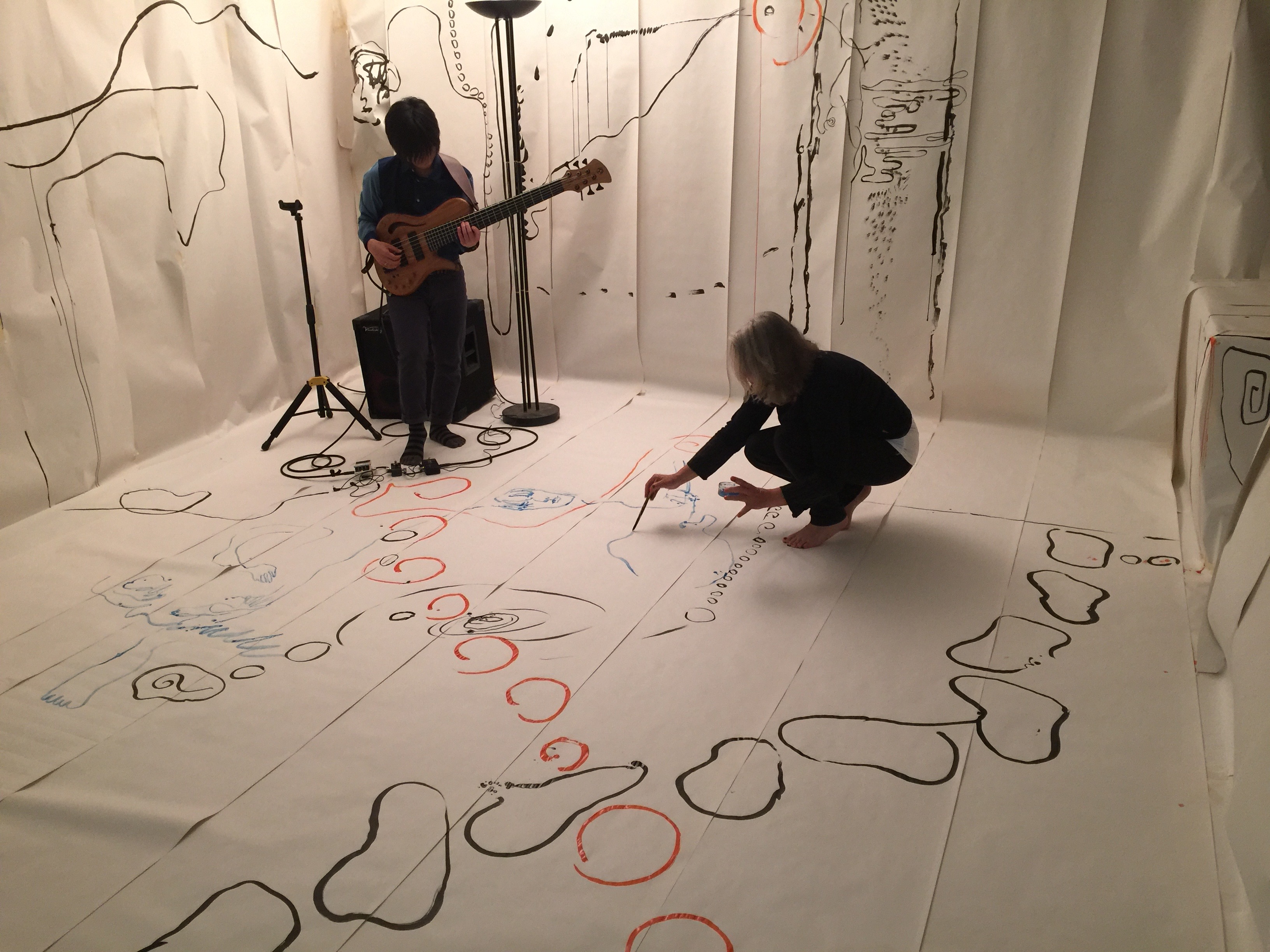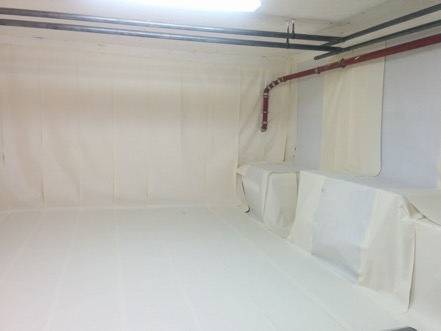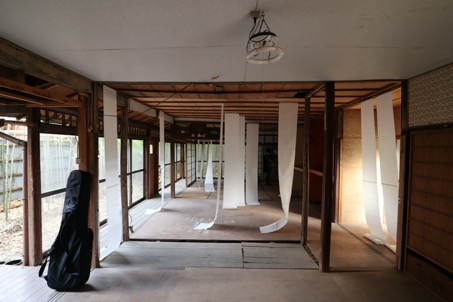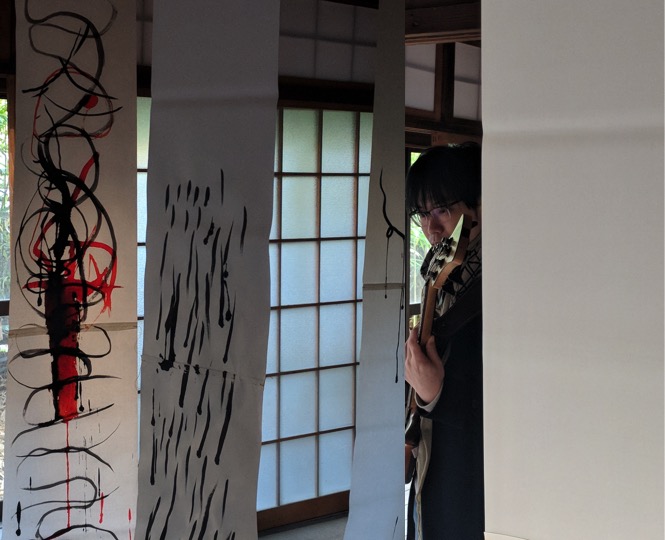Edition 2017 “Graphic Scores”
Contents
Guide 2017
Editorial 2017
Content of this edition
Guide 2017
This new edition is presented in the form of a roadmap, reminiscent of the metro map of our first formal proposition (2016 Edition), taking as basis a photograph of a painting by Lyon artist Christian Lhopital (we thank him for his generous contribution). We took advantage of the presence of seismic “faults” on this painting to use them as lines for connections between what we call “known places” [“lieux-dits”] in a meaningful way. Some contributions are grouped together on the map in regions (Treatise, films, documentation). The map consists of two big categories:

- An artistic performance (audio or video) of a graphic score, which can be triggered by clicking on the “known place”, that is the name of the contribution. An explicative, theoretical or poetical text appears when one goes from one known place to either of the two neighboring “known places”, in the form of a collage with the text of the neighboring contribution.
- Performances of Cardew’s Treatise, which are clustered in one part of the map and are presented in the same format.
- Three musical illustrations of films.
 These are reference articles, interviews or documentation pertaining to the question of graphic scores.
These are reference articles, interviews or documentation pertaining to the question of graphic scores.
You can move freely in the new map by clicking on any of the names of the known places. But the spirit of our approach is definitively on the side of taking a path following the lines, or seismic “faults” (as in “San Andreas fault”): the strolling from one known place to its neighbor reveals a collage of texts or spoken words provided by the contributors. We strongly encourage you to follow a pathway along on a fault line.
Editorial 2017
Music is irreducible to the spoken word, it is well understood, no language structure can account for it. In order to say that there is nothing that can be said about the nature of music, nevertheless one has to say it.
The idea that sounds cannot be represented by signs, images, by the visual world in general, is less often expressed. Any sonority that cannot be simply measured – as for example timbre in its global complexity – could not be, according to this enunciation, reduced to a system of signs. The accumulation of signs necessary to represent the totality of the sound matter would render the notation unreadable. In order to demonstrate the impossibility of representation, one has to demonstrate it by signs.
Already two paragraphs full of pointless signs for expressing the pointlessness of the effort to conciliate the sonic and visual realms. Yet, in order to make music, one has beforehand to telephone each other, to talk – a language on the subject of music – and then to take from one’s pocket a diary in which to inscribe the place and time of the encounter – a graphic writing linked to the practice of music. Even in the case of an impromptu encounter, the very decision to make music together can be considered as an inscription. Would that allow the naming of this type of process “graphic score”?
The visual elements inscribed on the page of the diary do not prescribe sounds that will be produced at this date, in that place which is associated with it, and with the persons who have written the same “score” in their note book. The graphics in the diary, foreseeing what will happen at such a date and in such place allows the definition of the time and space of the music, the partial planning of its unfolding. As for the rest, anything may happen. The sound combinations and their eventual meaning have to be elaborated at the moment of the encounter.
Graphics, which determine something different from the musical materiality in itself, give that delicious impression of needing no mediation whatsoever: everybody can have access to it in an immediate manner without difficulty. The presence of a score assumes the same function as a totem in the religious and enigmatic sense: it implies the obligation to do an action, some movements, some sounds, and its absence paralyzes. But if the mediations are not provided by the graphics, they remain necessary elements for action to take place. One has either to call on some resources – knowledge or know-how – already present in the performer’s realm, or to invent some kinds of mediations – codes, rules, different means to transform the visual into sound. The advantage that graphic scores have in relation to the dryness of the daily notebook inscriptions, is that they contain generally enough salient elements for giving rise to codes, either in an existing framework (recalling for example notational systems already in use), or in some framework to be invented by the participants. Everybody can have access to action, on the condition that the lack of mediations specified in the graphic score could give rise to mediations – instituted or to be invented – appropriate to the situation of the participants.
This is precisely the PaaLabRes project: a) to conciliate free sounds and academic language; b)to emphasize the profound implication of artists in production and the access for all to practices; c) to connect the well identified objects with those which have to be continuously re-actualized; d) to bring together the private space with public presentations. And let’s not forget hybrid activities, which get artists to think outside their narrow professional corporate world. In other words our aim is to conciliate the visual world irreducible to sounds and the sound world impossible to represent; in this way to go beyond the “readable”.
The use of graphic scores is today widespread in extremely varied contexts and aesthetical modes of behavior. The new edition “Graphic Scores” on the PaalabRes site [paalabres.org] shows a good sampling of this diversity, without pretending to cover the field in an exhaustive manner. For us, the confrontation of realizations by very different groups is of particular importance: professionals, amateurs, students, young pupils, electroacoustic realizations, contributions based on original works by visual artists. This diversity, which is also a good representation of the democratic character of practices implying graphic scores, is expressed in particular around Treatise (1963-67) by Cornelius Cardew, a referent work for many musicians: seven interpretations of this piece are presented.
Contents of this edition
Several regions are identified on the map:
- « Treatise » : The graphic score by Cornelius Cardew, Treatise (1963-67) is composed of 193 pages presenting 67 different graphic elements, certain of which are borrowed from traditional musical notation. According to John Tilbury, « Treatise was the culmination of a trilogy of works (with Autumn 60 and Octet ’61) in which this essential, human dialogue was re-opened, explored and refined. Rather than prescribind sounds Cardew sought to stimulate, provoke and inspire through a visual score of astonishing scope and imagination » peformers’ capacities. This score is still today considered as a major reference and often performed in various realizations. This region is composed of:
- Cardew: A collage of texts (in French) on Cardew’s Treatise (by Cornelius Cardew, John Tilbury, David Gutkin, Christopher Williams, Matthieu Saladin, Keith Rowe, Arturas Bumsteinas, Laurent Dailleau, Jim O’Rourke and Jean-Charles François).
- Saïki: An interview with Xavier Saïki, member of the collective Ishtar, on Treatise by Cardew.
- 7 realizations of Cardew’s Treatise by very different groups: on the one hand, versions by professional groups, the collective Ishtar, the ensemble Dedalus and a trio (Pedro Branco, José Ceitão and Etienne Lamaison) ; on the other hand versions realized in educational contexts by the students of the HEMU of Lausanne (Haute Ecole de Musique de Lausanne), students from Cefedem AuRA, young students of the EPO program at the National Music School of Villeurbanne, and young students at the Miribel Music School (near Lyon).
- « Films »: graphic scores can also be presented as animated images in time. Many projects are centered on the sonorization of silent films, particularly through improvisation while looking at the film. Three examples of sonorization of films are presented in the 2017 edition:
- 11e Année : The trailer of the film The 11th year (1928) by Dziga Vertof was sonorized by Clélia Bobichon, Jean-François Charles, Guillaume Hamet, Krystian Sarrau, Sébastien Sauvage et Nicolas Sidoroff. You will find in between the known-places « Zola » and « 11e Année » information about the practical modes of operation while realizing this project, by Nicolas Sidoroff.
- Zola: The primary school Emile Zola in Villeurbanne organized during the year 2016-17 the realization by the pupils of a film. One class was in charge of realizing its sonorization with Pascal Pariaud.
- Bois: The sonorization of the cartoon Bois by Lucie Marchais was realized by the improvisation workshop of Pascal Pariaud at the National Music School of Villeurbanne. Lucie Marchais was participating as a musician in this workshop.
- « Documentation »: We can find in the world a particularly rich collection of graphic scores difficult to categorize, as many different practical contexts use this kind of tool. In this edition two known-places are proposed concerning the documentation of graphic scores:
- At the known-place IIMA, International Improvised Music Archives (http://www.intuitivemusic.dk/iima/legno1uk.htm) you will find information on the extremely rich documentation collected by the Danish musician Carl Bergstroem-Nielsen. An important part of these archives dedicated to improvisation concerns graphic scores since 1945.
- At the known-place Aleph : the Ensemble Aleph organized in 1983 an exhibition of graphic scores at Issy-les-Moulineaux, in the context of the « Atelier Musical » directed then by Sylvie Drouin. The catalogue of the exhibition « Musique et Graphisme » is presented in this known-place. The ’Ensemble Aleph was at that time a young contemporary music ensemble, just created by Dominique Clément (clarinet), Sylvie Drouin (piano), Monica Jordan (voice), Françoise Matringe (piano) and Christophe Roy (cello). The ensemble worked at that time with the composer Dan Lustgarten, who actively participated in the shaping of the exhibition and writing the texts of the catalogue.
Three reference articles on the subject of graphic scores and more generally on the issues of visual representation of sound, of musical notation and of musical forms of writing are presented:
- “Drastique ou plastique ?” an article by David Gutkin (the English version of this article, « Drastic or plastic? » has been published in Perspectives of New Music ). The author explores the contents of the 1959 lecture by Stockhausen, « Musik und Graphik » de Stockhausen, 1959” in historical and critical perspectives.
- “Réflexions sur les partitions graphiques” by Etienne Lamaison, extracted from his recent thesis on non-procedural graphic scores. For this author, the notion of non-procedural graphic scores can be defined as scores leaving a total freedom of interpretation of the visual signs to the performers.
- In October 2019, a new known-place was created: “Ecriture et Oralité” (« Writing and Orality »), an article by Dominique Clément. The author confronts here in a double text, the written formal version and the oral transcript of a lecture he delivered in 2018 at the Cefedem AuRA.
Two interiews present effective practices of realizations of graphic scores in various contexts:
- An interview with Pascal Pariaud on his pedagogical practices linked to graphic scores.
- An interview with Xavier Saïki, member of the collective Ishtar, on Treatise by Cornelius Cardew.
The other known-places present various realizations of graphic scores sent to PaaLabRes after the 2017 call for contributions. Here is the list:
- sono ba : Frédéric Mathevet, Sono ba 2 (extract): the appartment of my father/of my mother.
- Gray Area : a graphic score by Julie Mehteru, Gray Area, performed by Bruno Graca and Etienne Lamaison, clarinets without mouthpiece.
- Apples : Christopher Williams, Apples are Basic, performed by Mary Oliver, viola and Rozemarie Heggen, double bass. Serigraphs by Corita Kent.
- Pressure/La mer: Alex Ness et Yoni Niv audiovisual compositions, Pressure, La mer, 2010.
- Aifoon : Aifoon,artistic and pedagogical organization, Ghent, Belgiim. Graphic scores realized in children’s workshops and performed by Marc Galo, electric guitar, Stefaan Smagghe, violin and Thomas Smetryns, dulcimer.
- …out of the air… : Elain Barkin, … out of the air…, for basset horn, 4 tracks tape and graphic score. This work was created in collaboration with the clarinetist Georgina Dobrée (1930-2008). The performance was recorded at the University of Wisconsin, Eau Claire, on March 4, 1993.
- ENM : 3 scores written and performed by students participating in the improvisation workshop of Pascal Pariaud at the National Music School of Villeurbanne. Charlen Guillot, Kerwin Marchand-Moury and Léa Vernet.
- Yantra : David Samas, Yantra,for the Gamelan Encimal (Stephen Parris, director). Performance of December 11, 2016 at Mills College, Oakland, California.
- Unbearable Lightness : Carl Bergstroem-Nielsen, Towards an Unbearable Lightness 1992, for any instruments or voices capable of producing some « sombre et heavy » sounds and also some « light » sounds. Performance by the Ensemble Supermusique of Montreal, Canada (2013).
- London : Guillaume Dussably, 6 travellings in the map of the London Underground, for modular synthesizer (2017).
- Tres : Frederico Llach, Tres (three in Spanish) for three performers. Performance by PFL Traject, Pascal Pariaud, clarinet, Jean-Charles François, percussion and Gilles Laval, electric guitar, University of California Santa Barbara, February 2015.
- Schème moteur : Alain Savouret, Schème moteur, performance by Ultim’Asonata, Festival « Musique Action » 2017, Vandœuvre-lès-Nancy. With Alain Savouret, high-speaking music , Yannick Herpin, clarinet, Violaine Gestalder, saxophone, Noémie Lapierre, clarinet, Gaspar Hoyos, flûte and Aurélien Pouzet-Robert, hautbois. In 2019, two new versions of this score are added, played by the group Petit Goulash (with Franck Testut, bass, Pham Tronh Hieu, drums, Gilles Laval, electric guitar, and Nicolas Sidoroff, trumpet).
- Constellation Scores : Rob Mazurek, trompetist and visual artist, Constellation Scores, an exhibition of his lithographs in 3D at URDLA, Villeurbanne, September/November 2017.
- powerpeinture : Laurent Grappe, powerpeinture, video, English translation by Ephia Gburek, la fab-ka, studio doitsu, mai 2017.
Le Collectif PaaLabRes : Samuel Chagnard, Guillaume Dussably, Jean-Charles François, Laurent Grappe, Karine Hahn, Gilles Laval, Noémi Lefebvre, Pascal Pariaud, Nicolas Sidoroff, Gérald Venturi.
Return to English Editorial
Contributors to the 2017 edition
English Editorial 2016



